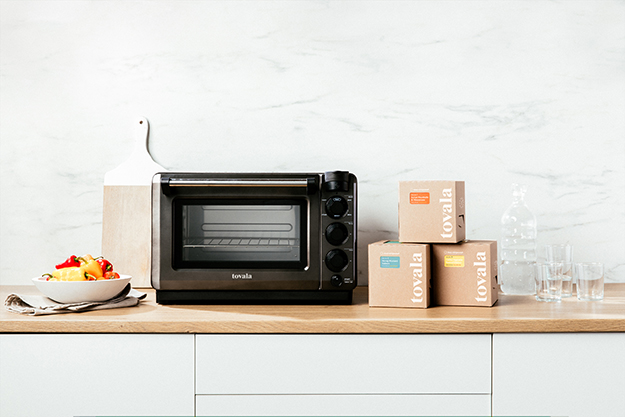

We may earn revenue from the products available on this page and participate in affiliate programs. Learn more ›
When DIY inspiration strikes, you’ve got to go with it. For me, that meant impulsively salvaging a rusty, musty, 1940s electric oven with a vague plan to turn it into a vanity and sink. It also sometimes means bringing in some help, which is how an auto mechanic ended up using body shop techniques on a kitchen appliance destined for a bathroom.
My vision began to materialize when I first spotted the beat-up, creamed corn-colored electric roaster at a sprawling upcycle warehouse just over the Washington, D.C. line in Edmonton, Maryland. I was there, I thought, to find a discarded dresser that I’d paint, top with a reclaimed basin, and then plumb. Instead, I paid Community Forklift $99 for a vintage piece with some dents and a bit of rust, but also a chrome top that popped open on the first try.
Inside, I found an illustrated instruction book filled with recipes and images of a proud-looking woman in a June Cleaver-like outfit—with pearls, pumps, and all—roasting meats, potatoes, and other vegetables in three separate lidded containers that fit like puzzle pieces inside the oven’s cavern. She even had an apple cobbler baking in a fourth one. When I plugged it in, the stove still worked.
My first thought was to affix a basin to the chrome top; but, at 5-foot-4, I would have needed a stool to wash my hands. Plus, I wanted to be able to open and close the lid. So, I nixed that idea. Then I thought I’d put the basin inside the oven section, but when I removed all the little containers with lids, I found the basin I’d bought was too big and awkward-looking. So, I kept thinking. And then it came to me: The roasting cavern itself would be the basin. I’d be able to keep the chrome top closed and visitors would walk into my powder room to find an oven. Perfect.
Not everyone took to my conversion idea with rapid applause. Even the plumber who was working on my renovated 1914 D.C. rowhouse was perplexed, likely by what I was asking him to do and because I assumed he knew how to do it. He didn’t.
It was hard to find someone who did. “Hi, I’d like to turn an old electric roaster into a pretty vanity and sink. Can you help me do that?” was how I began myriad phone calls with unsuspecting tradespeople. Many went unreturned. Others ended abruptly. I even drove around with the oven in my car trunk for a few months to physically show people what I was talking about. And then I found Sarven Mermer. At 27, he’d owned his body shop, Eurowerks, for six years already.
Like all the other conversations I’d had about my roaster rehab, my first chat with Mermer was also bizarre.
“My initial reaction when you called me was, ‘That was an odd thing to work on,’” Mermer recalled in a recent phone conversation. We hadn’t spoken in about five years, but he remembered the lady with the oven overhaul.
But Mermer quickly realized what others hadn’t—fixing my oven was like fixing a car. He approached my roaster as a mini-roadster, albeit one without wheels or an engine.
“It’s the same material as a car … sheet metal. So, as long as it’s a material we can work with and we have experience with, anything can be done,” he said. “It was beat up, but it was something we could tackle.”
Mermer’s attitude was exactly what I was looking for. He would be my converter. I picked “Mercedes Red” as the oven’s final color and it was off to the races.
“We took it apart, piece by piece … like a beat-up car, and went to work,” recalls Mermer. “We did exactly what we would have done on a car, but we did it on an oven.”
How it all came together
Eurowerks first tackled the oven’s many dents, treating the appliance like a dinged-up car door. They smoothed the metal pieces with a dent puller, slathered fiberglass paste on the repaired spots, sanded them down, then primed them for painting before sanding them again. Then, they rebuilt the roaster, without its chrome top, for painting.

They put the oven in a room built to hold a truck or large SUV. Like an operating room, the space was flooded by fluorescent light. Unlike an operating room, it was sealed shut with steel doors fitted with filtration systems to help ensure that dust or other airborne particulates didn’t contaminate the paint job. The roaster looked miniscule in that great room, less than 1/16 the size of its usual occupants. “I used about the same amount of paint that’s used to paint a fender. It wasn’t much,” Mermer recalls, with a chuckle.
Once the four coats of paint had dried, they really made the oven shine with a high-end clear coat specially made for European car brands. To rid the clear coat of any imperfections and create a smooth, shiny surface, they used 3,000- to 5,000-grit sandpaper—first on a power sander with water (wet sanding) and then by hand. They also polished the chrome top, which was fairly rusty, and reattached it.
At this point, the oven was pretty, but I still didn’t have a sink. Mermer kept working.
“Mechanical engineering is my hobby … I like bringing old stuff back to life,” he told me. “I went through some ideas and made it happen.”
There were some challenges with the plumbing and how the water would drain. For one, the bottom of the oven was flat, so the water would accumulate there instead of draining as it should. Mermer removed the fire-retardant insulation from around the oven’s heating element to expose the bottom of what would become the sink—where the plumbing would go. Then, he came up with the idea to punch down the center of the roasting cavern to give it the slope necessary for water to drain.
Mermer’s final job was to drill a hole so the vanity could be plumbed. He also test-fitted some piping to make sure the plumbing would actually work.
It was all done in about two months, at a cost of $250.
“We didn’t know how much to charge you. There was no guide,” Mermer remembers, laughing.
When I brought home my funky, bright red, chrome-topped vanity and sink, all it needed was a plumber to add and seal a drain, install piping, and connect “The Little Red Roaster” to the plumbing in the wall. Of course, I also needed a faucet. It wouldn’t be part of the sink, though—I chose to put it on the side wall, out of the way so the chrome top over the basin could be opened without interruption. It’s the most basic faucet system I could find, and when it’s not in use, the fixture itself lays flush against the wall to the right side of the oven. Once visitors figure out how to open the top—I’ve provided instructions in the form of a rhyming poem on the wall nearby—they’ve simply got to swing the faucet over the basin to wash their hands.
I’ve received a few criticisms from guests (and my children) “annoyed” that they had to read a poem to operate a bathroom sink. But overall, most people leave the powder room with a goofy grin, waxing “poetic” about “The Little Red Roaster” that I did invent.




















